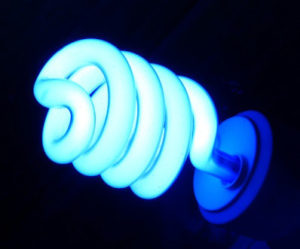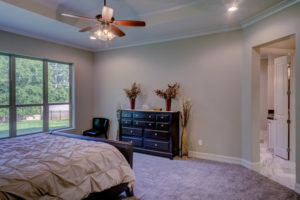It’s amazing how much energy is wasted in the average home. Saving energy is not only good for our planet, but it can save you money. Here’s a list of some easy ways to save energy in your home.
Install ceiling fans
Ceiling fans deliver energy savings in both summer and winter. In the summer, set the fan to blow the air down from the ceiling. Feeling the air on your skin makes you feel cooler without needing to lower the room temperature.
In the winter, set the fan to blow up toward the ceiling. You won’t feel air blowing on you, but the fan will circulate the warm ceiling air around the room, helping to heat the room more evenly.
To set the air in either direction, look for a small switch or button on the fan or the remote.
Install a programmable thermostat
A programmable thermostat can be set to change the temperature on heaters and air conditioners when you’re not home or at night while you sleep. However, don’t go too far outside your normal temperature range, or you may use additional energy to bring the temperature back to your desired setting. For example, if you keep your heater at 72 degrees, don’t go down more than three or four degrees at night, or while at work. You don’t want the system to work too hard to bring it back up to your desired temperature. In some climate zones, a programmable thermostat can save up to $150 a year in energy costs.
Here’s a programmable thermostat tip: If you’re out most days at work, set the thermostat to come back up to temperature one hour before you arrive, so you’ll feel warm and toasty (in winter) or nice and cool (in summer) when you get home.
Replace Incandescent lights
 Did you know that about 11% of your home energy budget goes into lighting? That’s why it pays to get rid of those old, inefficient incandescent bulbs. On average, incandescent bulbs only use 10% of the energy they consume to create actual light. The remaining 90% is turned to heat. Two energy-saving alternatives are compact fluorescent lamps (CFLs) and light-emitting diodes (LEDs).
Did you know that about 11% of your home energy budget goes into lighting? That’s why it pays to get rid of those old, inefficient incandescent bulbs. On average, incandescent bulbs only use 10% of the energy they consume to create actual light. The remaining 90% is turned to heat. Two energy-saving alternatives are compact fluorescent lamps (CFLs) and light-emitting diodes (LEDs).
CFLs reduce energy consumption by 75% and are estimated to last ten times longer than incandescent bulbs. The downside is that they contain mercury. You don’t want them to break in your house. They also must be recycled carefully. Never put CFLs in with your regular trash. Big box stores such as Lowes and Home Depot have recycling bins for CFL bulbs.
LEDs save even more energy. They may seem expensive up front, but they are estimated to last more than 50 times longer than incandescent bulbs (up to 11 years). There are no moving parts or filaments, and they don’t contain mercury. They consume even less energy than CFLs. Some users find them too bright, but others like the white, daylight feeling of LEDs.
Install surge protection power strips
Surge protection power switches serve two purposes. First, they protect your appliances in the event of a power surge. Second, they have a shutoff switch that will cut power to appliances when not in use. Don’t worry about major appliances, such as refrigerators, washers, dryers, ovens, etc. Put everything else on surge protection power strips and turn them off when not in use.
- Turn off computers when not in use. Computers account for up to 3% of a home’s energy consumption. Be sure to shut down properly, and then flip the power strip to the off position.
- Put TVs, stereos and other devices on power strips, and turn them off when not in use. Note: If you record a lot on your DVR, you need to keep it in standby mode, so don’t put it on a power strip.
- Unplug phone chargers when not in use. As long as they are plugged in, chargers use electricity.
Seal air leaks in your home
Sealing and insulating your home is easier than you think. There are lots of fixes you can do yourself. The first thing to do is identify and solve air leaks. Here are some areas where leaks can occur:
Electrical receptacles/outlets – In cold months, feel your switch plate and outlet covers, Are they cold to the touch? There may be air leaking inside the wall, and you could be losing heat through your outlets. Go to your local hardware store and ask for switch plate and outlet insulation foam. Just remove the plate covers and put the pre-cut foam inside to seal leaks. Use caution! It’s better to turn off the breaker to the outlets you are repairing to avoid risk of shock or electrocution.
Around pipes and wires – Places where pipes and wires enter the home may have openings where air can leak. Use expanding foam for large openings and caulk for small openings. Lexel sealant is a great caulk to use. It costs more, but it will last for many years.
Wall or window mounted air conditioners – Feel around wall or window units. If you feel air leaking, you can buy strips of foam insulation to stuff into the openings. If the openings are very thin, just use caulk around them.
Weather stripping around doors and windows – This one can be tricky. After years of service, weather stripping can become worn or damaged. Ask about the best weather stripping solutions at your hardware store. If you can’t get it right, you may need to hire a professional. One more things about windows: Go outside and check around, over, and under windows. If there are cracks, use Lexel caulk to seal them up.
Baseboards – Be sure to caulk around your baseboards to eliminate air leaks.
These are just some of the ways you can save energy in your home. Watch for more tips in upcoming newsletters and blogs.
Call Peter Young Home Inspections today
Get peace of mind when buying a home. Call Peter Young Home Inspections and schedule an appointment today.



